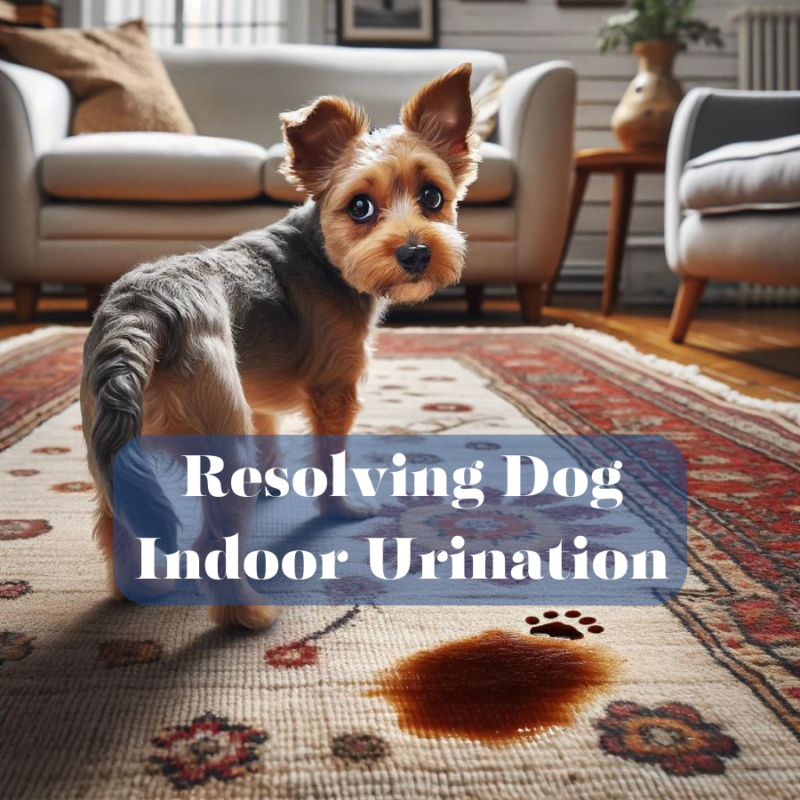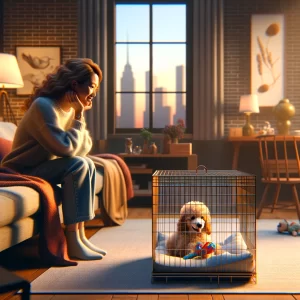
Effective Strategies for Resolving Dog Indoor Urination
Help! My dog is urinating in the house!!
Our cherished canine companions sometimes baffle us with unexpected indoor urination. However, there’s no need to worry as we delve into the causes behind this behavior and provide compassionate solutions to overcome this hurdle.
Possible causes for dogs relieving themselves indoors include:
- Incomplete House Training: If your furry friend is new to the home or a puppy, house training may take time.
- Medical Issues: Sudden indoor accidents may signal health issues like urinary tract infections or diabetes. Don’t hesitate to consult your veterinarian for a check-up.
- Stress or Anxiety: Dogs, like us, can get stressed. Life changes or new environments may trigger indoor accidents. Try behavior modification, training, or even a bit of extra TLC to alleviate stress.
- Marking Territory: Unspayed or unneutered dogs might be claiming their territory. Considering spaying or neutering can help curb this behavior.
- Old Age: Our senior companions may face incontinence due to age-related issues. Consult your vet for guidance on managing this natural process.
- Submissive or Excitement Urination: Sometimes, excitement or anxiety leads to accidents. Gentle behavior training can work wonders.
- Changes in Routine: Dogs thrive on routine, so changes can disrupt bathroom habits. Maintain consistency to help your furry friend adjust.
- Dirty Litter Box (for Indoor Cats): A clean litter box is a must for our indoor cat pals. Dogs might be tempted by the scent, so keep it tidy.
To tackle indoor urination, identify the cause, rule out medical issues, and implement friendly training and environmental adjustments.
Positive Discipline for Indoor Urination: Disciplining our dogs for indoor accidents calls for a positive and understanding approach. Here are some friendly tips:
- Rule Out Medical Issues: Consult your vet for potential medical concerns to ensure your dog’s health is in check.
- Create a Routine: To create a sense of predictability, create a regular schedule for eating, walking, and using the restroom.
- Supervise and Monitor: Watch carefully, especially during training, and guide your dog to the right spot.
- Positive Reinforcement: Celebrate outdoor success with praise and treats, reinforcing the positive behavior.
- Use a Command: Introduce a cue or command when it’s time for outdoor bathroom breaks to create a clear association.
- Clean Accidents Thoroughly: Clean indoor accidents with a pet-friendly enzymatic cleaner to discourage repeat incidents.
- Avoid Punishment After the Fact: Skip the scolding; dogs live in the moment and might not connect it to past accidents.
- Create a Designated Bathroom Area: Establish a go-to spot in the yard for bathroom breaks, making it clear where your pup is to go.
- Consider Crate Training: Gently introduce crate training as a safe space, helping with in-house training.
- Consult a Professional Trainer: For persistent challenges, seek the guidance of a friendly professional trainer who understands your dog’s unique needs. Remember, patience and positive vibes go a long way in house training.
Deterrent Sprays to Prevent Indoor Urination
Let’s talk about friendlier ways to prevent indoor accidents using deterrent sprays.
- Commercial Pet Deterrent Sprays: Explore the world of pet-friendly sprays available commercially. Follow the instructions for the best results.
- Citrus-Based Sprays: Dogs might not be fans of citrus. Create a spray using water and citrus juice to keep certain areas off-limits. Consider a commercial citrus-based spray
- Home-Made Vinegar Solution: Mix a white vinegar and water solution, applying it to spots that need a little discouragement.
- Cayenne Pepper: A sprinkle of cayenne pepper in the right places might do the trick.
- Ammonia: Dilute ammonia with water for a scent dogs might find a bit too intense. Use it with caution.
- Peppermint: Try peppermint oil or sprays for areas where you want a deterrent.
Caution: Use lemon juice carefully, considering your dog’s sensitivity to scents. We want to discourage, not overwhelm.
Consistency is Key! Keep it consistent and reapply as needed. A friendly reminder to your dog that certain areas are a no-go. Positive reinforcement is the name of the game. A friendly pat and treat can work wonders when your dog does the right thing.
Avoiding Outdated Discipline Methods
Regarding discipline, it’s best to leave outdated methods in the past….
- Rubbing a dog’s nose in urine doesn’t communicate the message effectively. Rubbing a dog’s nose may lead to defensive behavior, something we’d like to avoid. Dogs live in the present, and this method might leave them confused.
In-Depth Guide to Crate Training
Crate training is a method of teaching your dog to accept a crate as a familiar and safe location. This training technique can assist with house training, prevent destructive behavior, and provide your dog with a personal space where they can feel secure. Here’s a comprehensive approach to crate training your dog effectively:
- Choosing the Right Crate
- Select a crate that is large enough for your dog to stand up, turn around, and lie down comfortably, but not too large that they can use one end as a bathroom. There are various types of crates available, including wire, plastic, and soft-sided crates. The choice depends on your dog’s needs and your lifestyle.
- Introducing the Crate

- Introduce your dog to the crate in a positive manner. Place the crate in a common area where the family spends a lot of time. Keep the crate door open and encourage your dog to explore inside by placing treats and favorite toys inside. Never force them to enter, as the goal is to make the crate a welcoming space.
- Feeding Meals in the Crate
- Begin feeding your dog their regular meals near the crate, gradually moving the food bowl inside. This helps create a positive association with the crate. If your dog is comfortable, start closing the door during meal times and opening it as soon as they finish eating. Gradually increase the time the door stays closed after meals.
- Increasing Crate Time
- As your dog becomes more comfortable eating in the crate, start practicing longer durations of confinement. Encourage them to enter the crate with a command, such as “crate” or “bed,” and give them a treat. Start with short intervals (5-10 minutes) and gradually increase the duration as your dog shows signs of comfort. Always provide a comfortable bedding and fresh water if leaving them crated for longer periods.
- Creating Positive Associations
- Use toys and treats to make the crate a rewarding place. Giving your dog a special toy, like a puzzle toy filled with treats or peanut butter, can keep them occupied and associate crate time with positive experiences.
- Handling Whining or Barking
- If your dog whines or barks in the crate, it’s important to wait until they stop before letting them out, to avoid reinforcing the behavior. However, ensure they have been to the bathroom first to rule out discomfort as a cause. For puppies, nighttime crate training may require setting an alarm for bathroom breaks to prevent accidents.
- Gradual Departures
- Begin practicing short departures while your dog is in the crate to get them used to being alone. Start with just a few minutes and gradually increase the time you’re away. This helps reduce separation anxiety and teaches your dog that you will return.
- Overnight Crate Training
- Place the crate in your bedroom or a nearby hallway initially, so your dog doesn’t feel isolated. This can be especially comforting for puppies. Over time, you can move the crate to your preferred location as they become more accustomed to it.
- Avoiding Crate Misuse
- Never use the crate as a punishment. The crate should always represent a safe and happy place for your dog. Ensure that the crate is used appropriately and not as a substitute for exercise and interaction.
- Monitoring Crate Time
- Be mindful of how long your dog spends in the crate. Puppies and adult dogs should not be crated for too long. Provide ample playtime, exercise, and interaction to ensure your dog’s physical and emotional well-being.
Crate training, when approached with patience, consistency, and positive reinforcement, stands as a highly effective and humane strategy to safeguard your dog’s safety and enhance their well-being. It transforms the crate into a comforting space that supports their overall training and security. Emphasizing the importance of sensitivity, maintaining routine, and encouraging positive behavior are pivotal to a successful outcome. Should uncertainties arise, the expertise of a veterinarian or a professional trainer can be invaluable. This method not only promises a happy, accident-free home but also complements strategies for managing dog urine stains and odors, further detailed in resources like “Easy Triumph: Unveiling Secrets For Dog Stains And Odor Elimination,” ensuring a harmonious living environment for you and your pet. 🐾
This article may contain affiliate links. As an Amazon Associate, I earn from qualifying purchases.